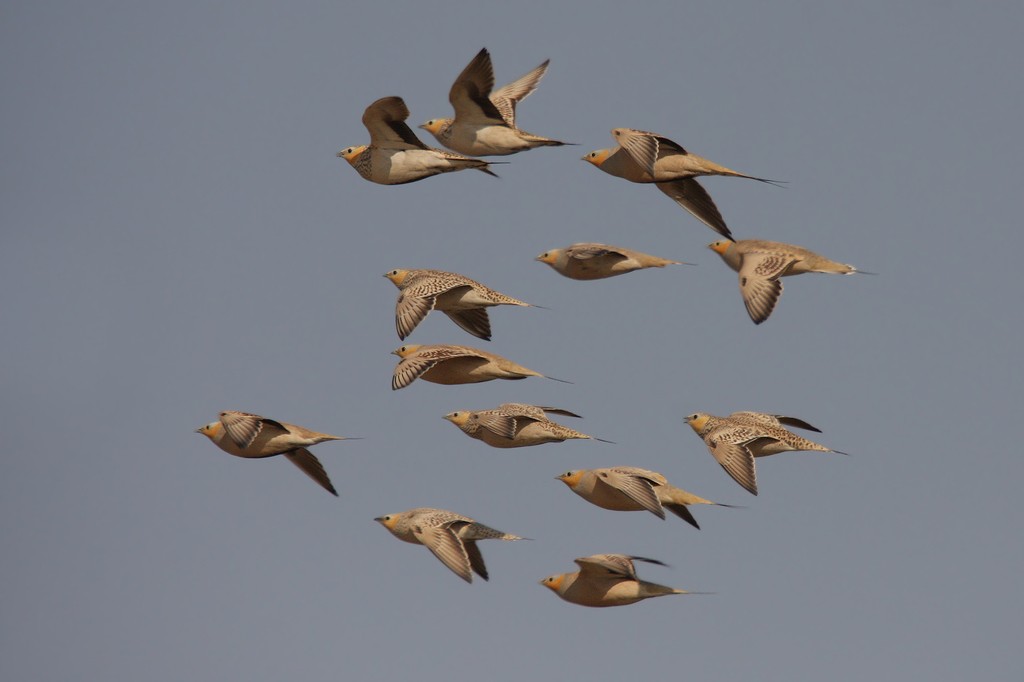Spotted Sandgrouse
A species of Sandgrouse Scientific name : Pterocles senegallus Genus : Sandgrouse
Spotted Sandgrouse, A species of Sandgrouse
Botanical name: Pterocles senegallus
Genus: Sandgrouse
Content
Description General Info
Description
The spotted sandgrouse reaches a length of about 33 centimetres (13 in). The male has a small reddish-brown nape surrounded by a band of pale grey that extends to the bill and round the neck in a collar. The chin, neck and throat are orange and the breast grey. The upper parts are pinkish-grey with dark flight feathers and dark patches on the wings, tail and lower belly. The primaries are pale with dark trailing edges, a fact that distinguishes this species from the crowned sandgrouse (Pterocles coronatus) which has completely dark primaries. The female also has an orange throat region but is generally duller in plumage than the male. The body colour is greyish-brown liberally spotted with small dark markings and with dark patches on the wings, tail and lower belly. The central tail feathers in both sexes are elongated but not to the extent that they are in the pin-tailed sandgrouse (Pterocles alchata). When flying overhead, a dark belly stripe is visible. 
Size
35 cm
Nest Placement
Ground
Dite type
Granivorous
General Info
Feeding Habits
Bird food type
Behavior
The spotted sandgrouse has a rapid wing beat and flies swiftly. Its call is a musical "queeto-queeto" which distinguishes it from other species of sandgrouse with similar plumage. The spotted sandgrouse is a ground-dwelling bird and feeds on seeds and other plant material that it finds among the scrubby vegetation of its dry habitat. During the breeding season it is solitary but at other times of year it is gregarious. Flocks move into a new feeding ground after a storm has stimulated new green growth. In the Sahara the spotted sandgrouse are particularly fond of a species of spurge and concentrate on this until the foliage begins to parch, after which the birds return to their normal diet of seeds. These are abundant on the desert floor, remaining in a dormant state until rain occurs. The birds are very wary and easily frightened. Their chief enemy is the lanner falcon which flies rapidly just above the ground and scoops up any unwary bird. The sandgrouse strategy is to have one bird flying high overhead. When it sees an approaching falcon it gives a warning call and the other sandgrouse freeze. So good is their camouflage that the raptor is unable to detect them and flies on. Sandgrouse need to make a daily journey to a drinking hole, which may be many kilometres from their feeding ground. They land a short distance from the water and maintain a sentinel system here too as, beside the falcons, mammal predators may lurk nearby and nomads may water their herds. When all is safe, another distinctive call from the sentinel bird sends all the others to the pool where their daily water needs are taken up within about fifteen seconds. The journey to the waterhole is undertaken at around dawn when the air is cool. Later in the day, when the air temperature may reach over 50 °C, the birds are inactive and have the ability to increase their thermal insulation when the air temperature exceeds their body temperatures. At very high temperatures they also resort to gular fluttering and gaping to cool themselves. At night, several flocks coalesce and fly off into the rocky desert far away from any vegetation. Each bird scrapes itself a shallow sleeping hollow by moving from side to side. There are no jerboas or other small mammals in these barren wastes so foxes and jackals do not roam there at night and the birds are safe. 
Distribution Area
The spotted sandgrouse is found in North Africa and the Middle East. In Africa its range extends through Morocco, Algeria, Tunisia, Libya, Sudan, Egypt, Eritrea, Somalia, Ethiopia, Djibouti, Mali, Mauritania, Chad and Niger. In the Middle East it is native to Oman, Saudi Arabia, Israel, Jordan, Syria, Iran, Iraq and Afghanistan and its range extends as far as Pakistan and north west India. In 2016, a flock of around a hundred birds arrived at Kutch after a gap of 19 years. It has also been recorded as a vagrant in Italy, the United Arab Emirates and Turkey. It inhabits deserts and semi-arid countryside and is largely resident although there is some local movement of flocks. The population size has not been firmly established but it seems to be stable and the bird seems to be common over most of its extensive range. It is listed as being of "least concern" by the IUCN Red List of Threatened Species. 
Scientific Classification
Phylum
Chordates Class
Birds Order
Sandgrouse Family
Sandgrouse Genus
Sandgrouse Species
Spotted Sandgrouse 